(RETURN)
SAIL
VOLUME I
I. BLACKWALL
PASSENGER SHIPS
THE
TWEED
(1854-1888) -1745 tons, length250ft, beam 39ft 6in, depth
25ft Built at the Bombay
Dockyard of teak as the paddle steamer PUNJAUB
for the Indian
Marine. She saw service as a troop
transport to the Crimea in
1854, in the Persian expedition in
1855-1857, the Indian Mutiny
and the
Muscat-Zanzibar
Commission in June 1860. In 1862, she was ordered to Britain to have
her paddle
wheels removed and
replaced by a screw. On
arrival in the Thames, the decision had been made to sell
her.
The
PUNJAUB was
purchased by John Willis, renamed THE
TWEED, converted to sail, and
became the flagship of the John
Willis & Son fleet. She made
some fast passages -
in 1873, Lizard to
Melbourne 72 days; in 1874, St Catherine's Point to Otago
78 days:and in 1875, Sydney to
Dungeness
69 days. In 1888, bound for China from New York, the old ship
was dismasted
off Algoa Bay, South
Africa, and a
steamer towed her into Port Elizabeth. She was not considered worth
repairing and was
broken up.
.
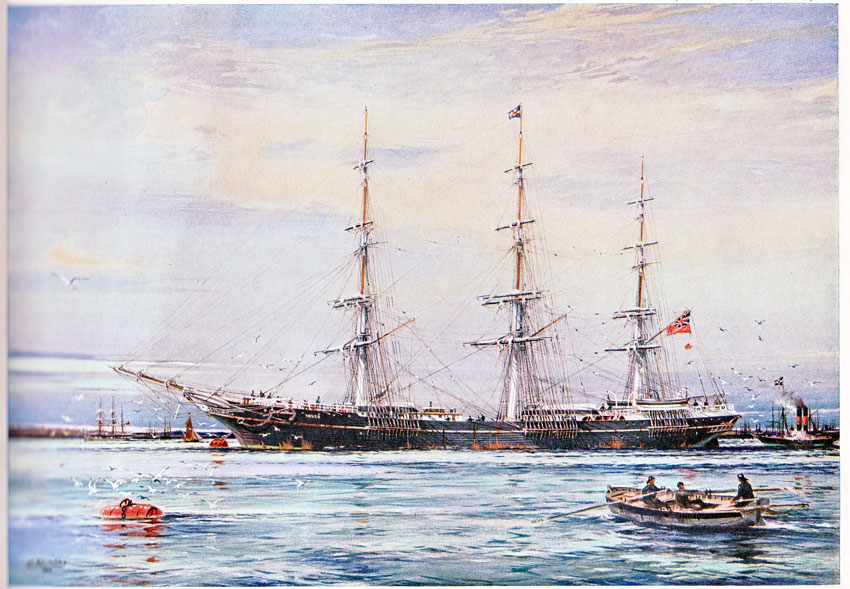 .
.
LA
HOGUE(1855-1886), 1331tons, length 226ft, beam 35ft, depth 22ft
9in.. Built by Laing at
Sunderland
for Duncan Dunbar.. She was a strongly built ship
with frames of oak, planking,
keelson, beams and decks of
teak She was also the first ship
in which the framing was trussed with
iron bars. She was for
thirty years in the
passenger trade to Sydney except
for one voyage in 1874 with
emigrants to New Zealand. She usually left
London in mid-summer
or shortly after and reached Sydney in 80
to 90 days. She would leave Sydney before
the end of the year and sailing
via the Cape of Good Hope would arrive back in the Thames by Easter.
She
was bought by
Devitt & Moore after Duncan Dunbar died in 1863. She continued in
the Sydney trade as before.
Her last voyage from Sydney was
in 1886 after
which she became a coal hulk at Madeira. .
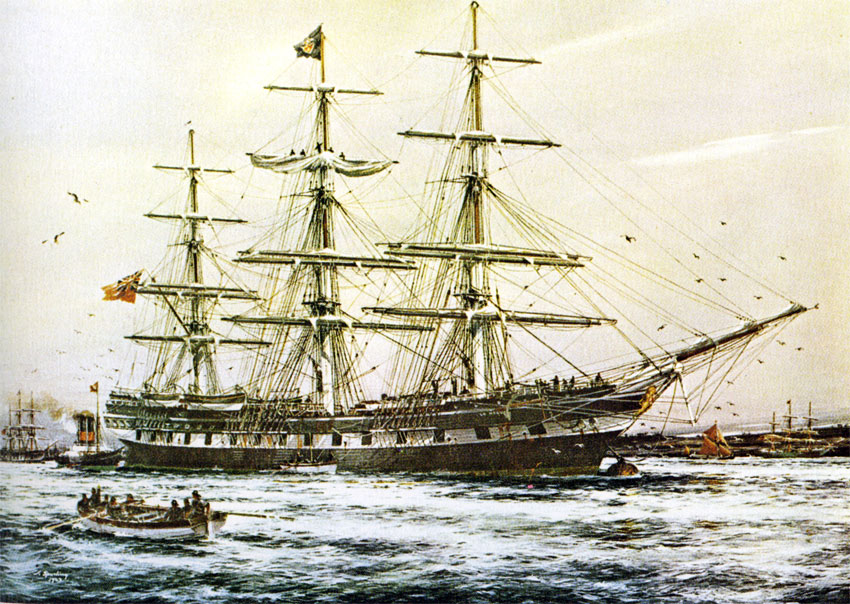
COSPATRICK (11856-1874),
1,200 tons, length 190ft, beam 34ft, depth 28ft 5in. Built for
Duncan
Dunbar at his Moulmein
yard for the Indian troopand passenger trade. Duncan Dunbar died
in
1862 and his
fleet was sold and taken up by London owners.
The COSPATRICK continued to sail
from
the Thames in the Indian
passenger trade. In 1873, she was sold to Shaw, Saville
and joined
the New Zealand
passenger trade. In September,
1874, she sailed for Auckland with general cargo,
429
emigrants and a crew of 44. South
of the Cape of Good Hope
the ship caught fire. Only two
ships boats, overcrowded with
81 passengers and crew in them
were able to clear the ship.
One of
the boats was not heard of again. The
other under the second
mate had 39 souls aboard. A week
later before being picked up by another ship there were 5 left -
the
second mate, three seamen and
one passenger. The second mate and two
seamen
were the only survivors.
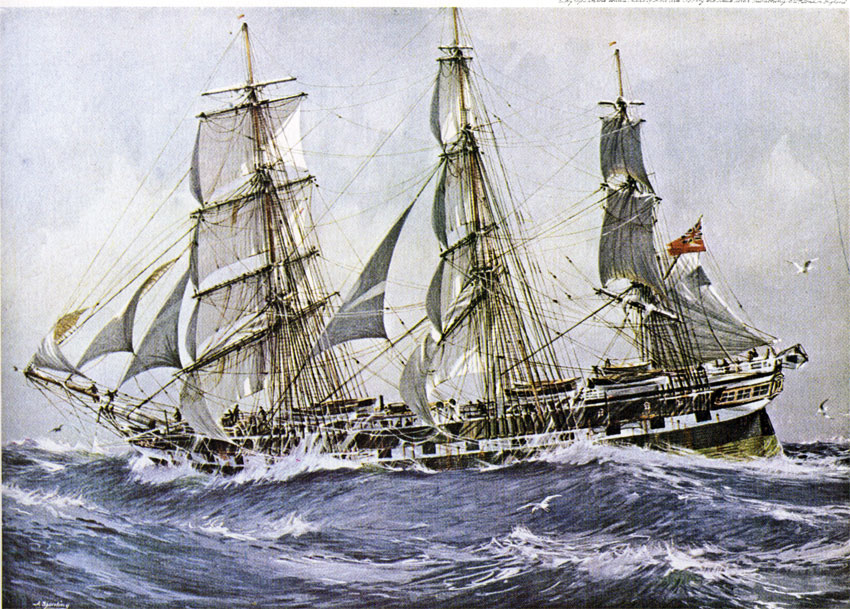
SOBRAON
(1866-1891),
2,130 tons, length 272ft, beam 40ft, depth 27ft. Of composite
construction (iron frame
planked), she was built by Alexander Hall,
Aberdeen, for Lowther
& Maxton.
The vessel was purchased by Devitt & Moore.in 1870. Up
to 1871, she was
in the Sydney
trade, but then transferred to the
Melbourne run.
She made one voyage a year
leaving London in late September
and leaving Australia for the return journey in early February..
She
was popular with passengers. In December 1891 after arriving in
Melbourne, she was
sold to the New
South Wales Government
for use as a reformatory. She was moored Sydney
harbour for the next
twenty years.
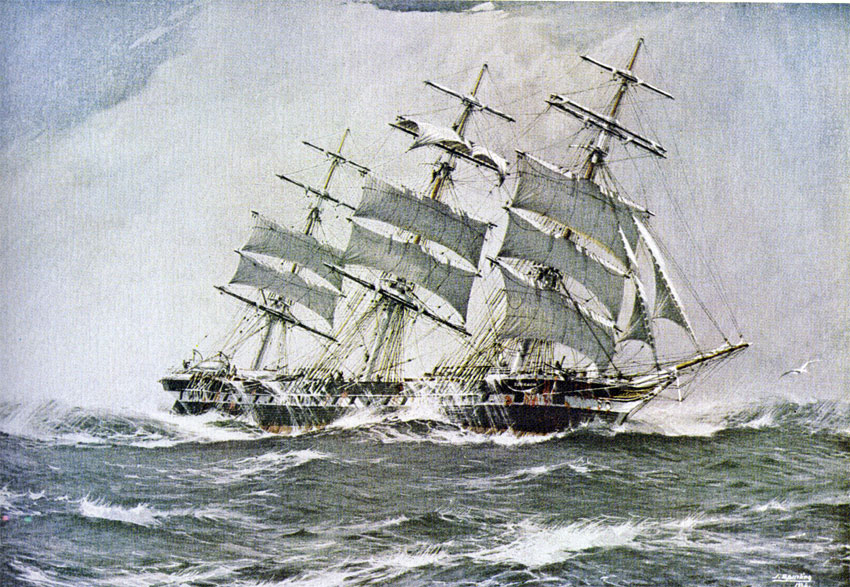
PARRAMATTA (1866-1899),
1,521 tons, length 231ft, beam 38ft 2in, depth 22ft 8in Of
composite
construction (iron frame planked), built by Laing,
Sunderland, as a passenger ship for
Devitt & Moore for
its
London to Sydney line. Basil Lubbock describes the vessel as
"practically an enlarged" LA HOGUE.
In the whole of her more than
twenty years
service with Devitt Moore she was on the London to Sydney
route.
The only change was that in the
eighties she
returned from Sydney via the more comfortable Cape
of Good Hope route
instead of around Cape Horn. Despite concern of her captain for
the
comfort of
passengers her passage times were good and often less than
89 days. In 1888, the vessel was
sold to
Norwegian owners and
after ten years by 1899 had disappeared from the registers.
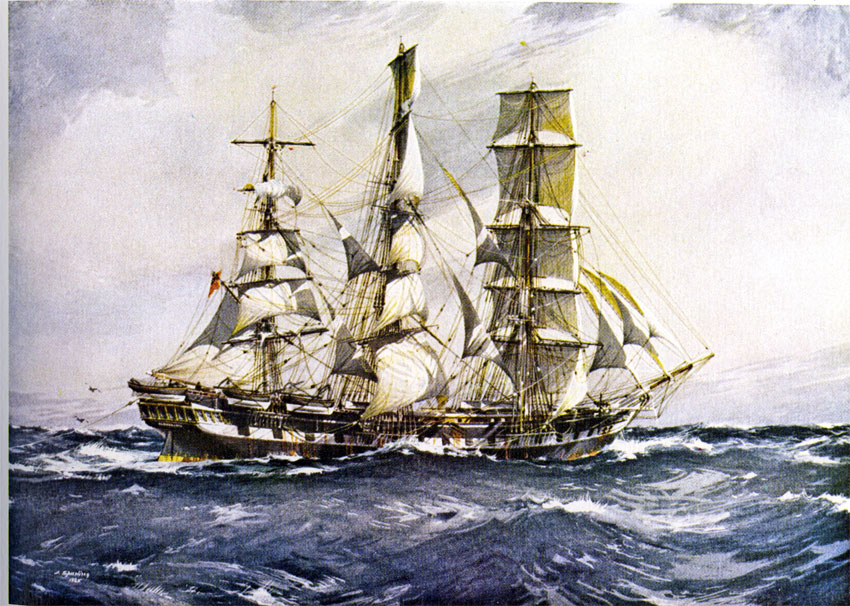
CARLISLE
CASTLE
(1868-1899), 1,458 tons, length 229ft 8ins, beam 37ft 8in, depth 22ft
8in..
Of iron construction, built at
the Blackwall yard, London,
for Green & Co.'s Melbourne
service. It
was the second iron ship built
at this yard. She was never a fast ship despite a large
sail plan.
In the
late eighteen seveties and early eighties, the passenger
trade
was moving to the steamships and the
CARLISLE CASTLE became
a carrier of wool and grain. She
was sold in the early nineties
to
Captain J. Robertson. In 1899, on a voyage from
Liverpool and Glasgow to Fremantle, the
vessel
was lost with all hands on a
reef in the approaches to Freemantle on the.West
Australian coast.
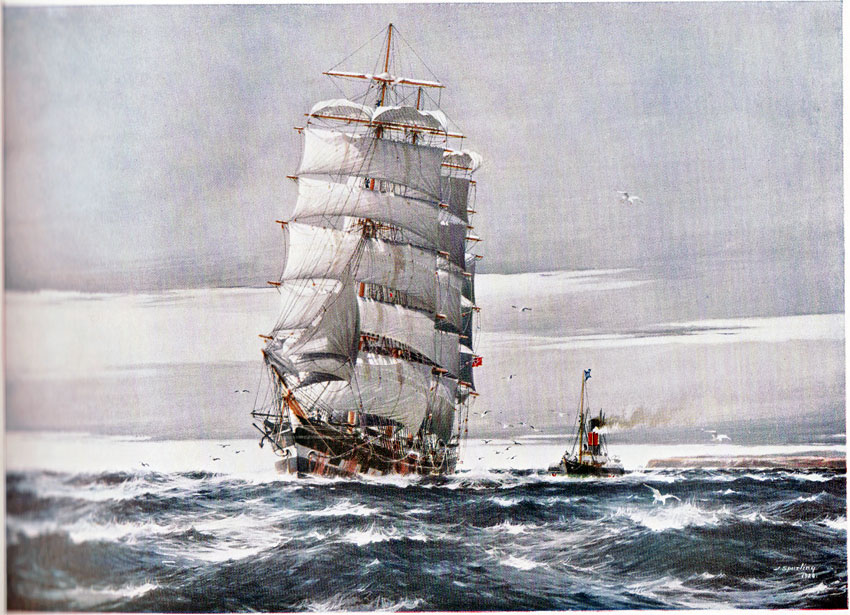
HESPERUS
(1873-1923), !,777tons, length 262Ft 2ins, beam 39ft 7in, depth
23ft 5in Of iron
construction, built
by Robert Steele, Glasgow,, for Anderson, Anderson & Co
(Orient Line). In
the
Spring of
1874, HESPERUS
made her first voyage to Adelaide with 416 emigrants. She was fast
and handled well. Her return
journeys were by
the Cape of Good Hope rather than Cape Horn.
She was popular
with passengers to
Adelaide and Melbourne up to
1890
She was purchased in
1890, along with her sisiter ship HARBINGER,
by Devitt
& Moore for their cadet training scheme.
It was at this time that the
ship made some of her best passages. In 1891, HESPERUS reached
Sydney in 88 days, in 1892 she arrived
at
Hobsons Bay (Melbourne)
from the Lizard in 71 days,
and in 1893 she reached
Hobsons Bay from the Lizard in 72 days.
In 1899,
Devitt & Moore sold
the ship to the Russian Government to be used as a training ship.
The vessel
was renamed
GRAND
DUCHESS MARIA
NIKOLAEVNA and stationed in the Black Sea as a training ship.
At
the outbreak of World War I she was at a British port refitting, and
was taken to Denmark and
spent the war at a mooring.
After the war she went through
several
changes of ownership and was
eventually broken up in Italy in1923.
.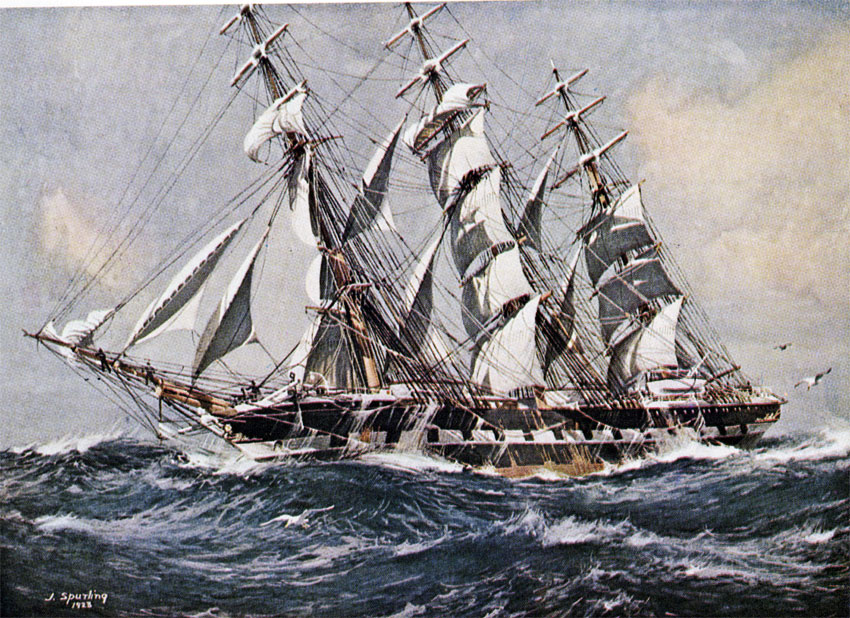
MACQUARIE (EX
MELBOURNE) (1875-1907) 1,857 tons, length 269ft 8ins, beam 40ft
1in,
depth23ft 7in. Of iron
construction, MELBOURNE was
built at Green's Blackwall Yard for
Green's
Blackwall Line. She was fitted out
luxuriously for passengers by the standards of
the time for the
Australian
passenger trade. She was the last of the Blackwall passenger liners. A
dry sea boat but
no record
breaker.
Her maiden voyage to Melbourne from the Start took 86 days and
her return
journey 104 days. On her second
voyage, she reached Melboune in 77 days. Lubbock comments
in
SAIL that this was the best she could do. .She was on the
Melbourne
run until 1887 when she
was purchased by Devitt & Moore as
a replacement for the PARRAMATTA in their Sydney
service.
She was renamed MACQUARIE for her second of voyage to
Sydney. In1904, she
was sold to a Norwegian company which
converted her into a timber carrier. She was sold again
after three
years and she became a coal hulk in Sydney. .
.
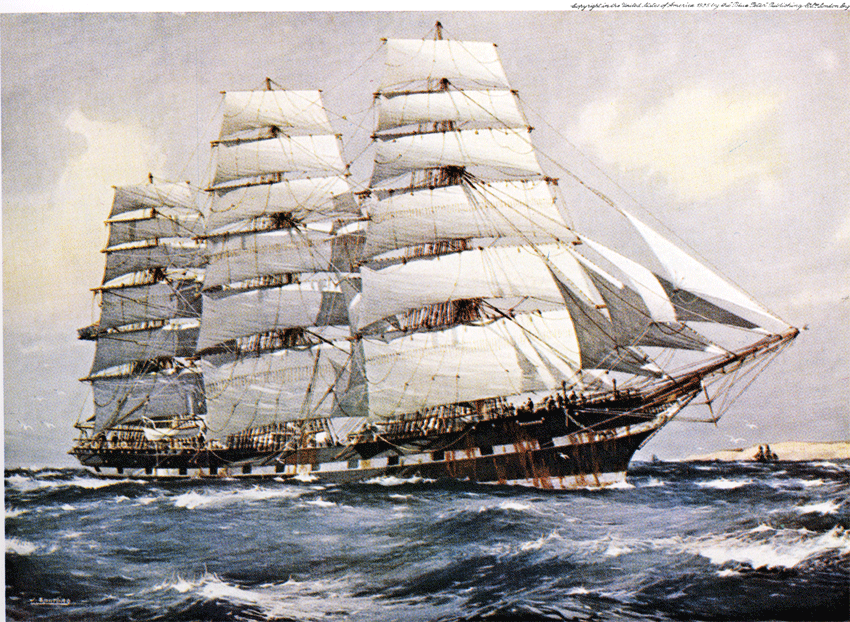
HARBINGER (1876-1910),
1,585gt, length 253ft 5ins, beam 37ft 6in, depth 22ft 4in. Built
of iron by
Robert Steele, Port
Glasgow, for Anderson, Anderson &
Co (Orient Line). There was
accomodation for
32 first class passengers and she could also
carry 200 emigrants tween decks.
She was intended as a
replacement
of th
TORRENS in the Adelaide passenger trade but was put instead
in the service to
Sydney.
!n 1890, she was purchased along with HESPERUS by Devitt &
Moore for that company's cadet training
scheme. She moved to the
Melbourne service and carried
cadets until 1897 when she was sold to Russian
owners. She
was still on the Register until
1905.
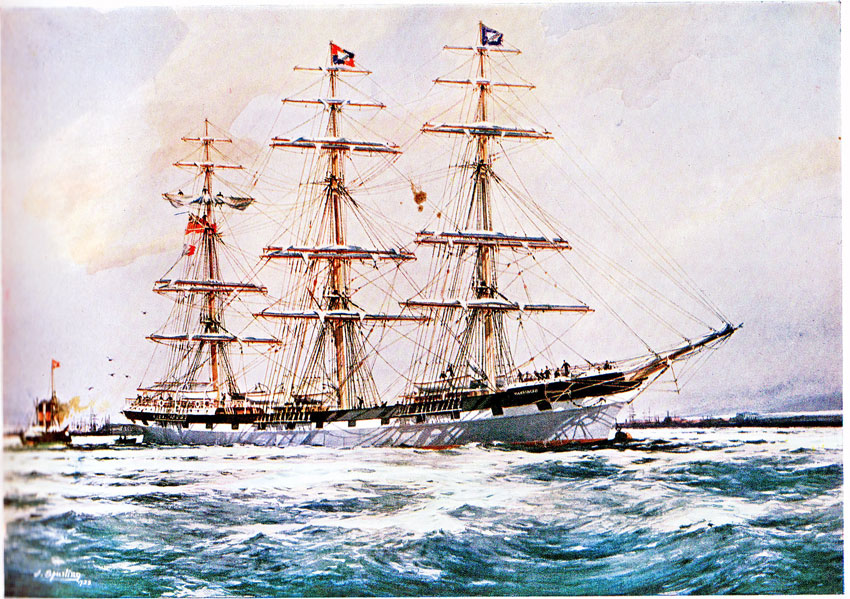
RETURN

 .
.





